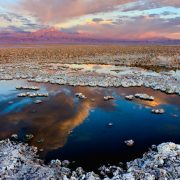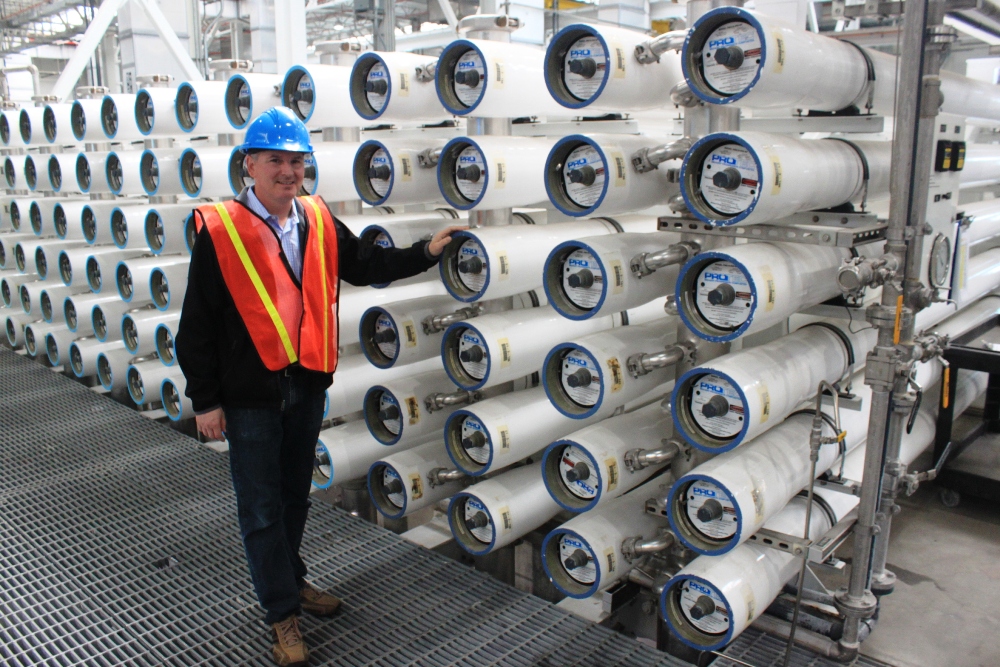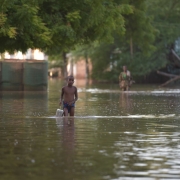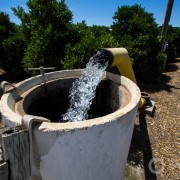Harnessing Mussels to Filter Fresh Water
A biological cure for contaminants is being studied.

Mussels native to Michigan’s fresh water. Photo courtesy of Daelyn Woolnough
By Amalia Medina, Circle of Blue
PHILADELPHIA – Water tanks line a room in this city’s Water Works on the bank of the Schuylkill River. Inside are small fish that are hosts to tiny organisms that researchers in the nation’s sixth largest city believe can help solve polluted waterways.
Tucked under the fish gills are microscopic mussels that will mature and become capable of filtering 10 to 15 gallons of water per day. Those data points make Lance Butler, who leads the research, hopeful. In essence, mussels are “our canaries in the coal mine for our water,” he said.
Butler is among the group of scientists across the globe who are looking toward such “blue infrastructure” to provide less expensive and more efficient systems to scrub contaminants from municipal wastewater. The role of native mussels in that fight may be crucial — if only they survive competition with non-native invasive mussels in fresh water havens like the Great Lakes.

Researchers work on floating zebra mussel enclosures on Gull Lake in 2005. Photo courtesy of Stephen Hamilton
The lab’s research
The mussels in the Philadelphia lab are exceptional filter feeders, said Butler, a senior scientist for Philadelphia Water Department Office of Watersheds. They can filter out particulate matter ranging from nitrogen and phosphorus to bacteria.
These mussel species were once abundant in the region. But their numbers declined due to industrialization, habitat loss, and acute, chronic water pollution.
Now, Philadelphia is looking to restore mussels that once performed a “critical ecosystem function for the city,” Butler said.
The team is currently trying to propagate five species of native mussels. The process involves facilitating relationships between the mussels and the host fish they attach to during their larval stage.
After selecting and collecting the host fish, the researchers acclimatize them to the lab using water from Philadelphia’s East Park Reservoir.
Then, the researchers extract microscopic mussel larvae, called glochidia, from gravid mussels. They pour them into buckets containing the fish, and when enough larvae have attached to the fish gills, the team returns the hosts to larger tanks.
Drexel University student Kathryn McFarland, who works in the lab, said the next step is to keep the fish happy and healthy while waiting for the baby mussels to drop off and be collected via a filter.
The mussels are then placed in a recirculating aquaculture system and left to grow while the team tracks their development. Perfecting this process is key to restoring local mussel populations.
To study mussels’ filtration abilities, the team puts one mussel into each of the 70 to 80 container systems in the lab and collects water samples every half hour.
The difference in water cleanliness is undeniable, according to aquatic biologist Shannon Boyle, who consults the department. Boyle said the water changes from nearly opaque to crystal clear overnight.
The team calculates filtration rates for each mussel species based on the collected samples. They also scale their findings in accordance with the mussel’s mass and account for metabolism changes throughout the seasons.
“How many pounds per nitrogen, how many pounds per phosphorus, how many colonies, or how much concentration of bacteria — these are all the questions that the water department wants to know,” Butler said.
The researchers plan on continuing this study for the next several years. Once they’ve collected sufficient data, they will have a template to determine the best course of action for mussel reintroduction into local waters — another process that will be closely observed.
The team is already experimenting with mussels outside the lab. In one Manayunk Canal site, they are studying how many mussels can be successfully introduced in a given area and the amount of nutrients the mussels filter.
“Obviously, you can’t just throw 100 or 1,000 muscles out there and say, ‘oh, that’s it, that’s what they’re doing,’” Butler said. “We have to determine their habitat needs, areas where we think that they can persist, and then sort of plant them or garden them in certain densities, and then monitor them.”
The team is also evaluating the prospect of using mussels as biological indicators.
This practice ranges from assessing mussel tissue to find contaminants, to using mussels to alert people to potential hazards. It has already been implemented in Minneapolis, for example, where mussels were used to assess water quality in wastewater treatment plants.
Daelyn Woolnough, a faculty member in Central Michigan University’s Department of Biology and Institute for Great Lakes Research, explained the practice. Woolnough said that when the mussels encounter poor water quality or potentially harmful contaminants, they close their filters. When the mussels clam up, the wires attached to their shells notify people to a potential contaminant. People can then run tests and pause the flow of water into lakes and rivers, Woolnough said.
In addition to wastewater, the team is also considering how mussels could be utilized in stormwater wetlands. Introducing mussels as a “pretreatment” before water enters a stream could result in streams receiving cleaner water, Butler said.
The studies are part of a growing approach toward sustainable solutions to climate issues, he said.
“There’s gray infrastructure, there’s green infrastructure, now we’re talking about blue infrastructure,” Butler said, “where you restore a system, where you create a system, and you introduce biological systems that were here.”

Five-day old juvenile eastern pond mussels. Photo courtesy of Lance Butler
Would it work elsewhere?
Similar research is happening across the globe, though Butler said most of it focuses on salt water.
Butler said looking at the potential of mussels in fresh water can help prevent pollution and clear up water in urban settings. The researchers hope it becomes a component of a comprehensive watershed management plan, he said.
“I see huge potential in it,” Butler said. “There are some obstacles that we need to address. That’s what we’re doing right now. We’re learning … and we are improving upon some of the techniques in the process.”
Using mussels as natural water filters is also an emerging prospect in the Great Lakes, where concerns about water quality are ever-present. But native mussels’ potential is eclipsed in the Great Lakes by a glaring impediment: invasive mussels.

Lance Butler and Shannon Boyle deploy caged mussels in the Schuylkill River in 2024. Photo courtesy of Lance Butler
Invasive mussels as biofilters
Invasive mussels have overtaken Midwest waterways since their introduction in the 1980s. They’ve become a primary target in the fight against invasive species, as they damage millions worth of infrastructure each year and impede recreation.
As states like Michigan crack down on the spread of invasive mussels, scientists are beginning to understand their impact on water quality.
Invasive quagga and zebra mussels are such effective filterers, Butler said, that if they were native, the team would be utilizing them for wastewater treatment.
The mussels’ sheer abundance allows them clear out vast amounts of water, according to freshwater ecologist Stephen Hamilton, who retired from Michigan State University last year.
Invasive mussels are successful in the region because of their ability to colonize, he said. At the size of a fingernail, they latch onto almost anything, including native mussels which are killed in the process.

Dead zebra mussels from Gull Lake in 2010. Photo courtesy of Stephen Hamilton
So, are these invasive mussels standing in the way of harnessing the potential of biofilters, or might they be an asset?
Scientists aren’t so sure.
Hamilton has researched the effects of zebra mussels on microcystis, a type of cyanobacteria that can form harmful algal blooms. He co-authored a 2021 study published in Ecosphere, which found a causal relationship between zebra mussels and microcystis.
The research began after scientists, stationed at the Kellogg Biological Station next to Gull Lake in southwest Michigan, noticed a decline in water quality. Surprised to see increasing microcystic blooms in a lake with such low phosphorus conditions, the scientists theorized that the recent introduction of zebra mussels in Gull Lake was responsible.
“Because the only change that we could think of that corresponded with this increase in microcystis was the arrival of zebra mussels, we decided to try to establish that connection to basically prove the hypothesis,” Hamilton said.
The researchers mounted 30-feet deep enclosures to floating rafts in the lake and put varying amounts of zebra mussels and phosphorus in each enclosure. After finding a positive correlation between the mussels and microcystis blooms, they expanded the survey to other bodies of water across Michigan. They found that at lower phosphorus levels, lakes with zebra mussels had about three times more microcystis.
The results support existing research showing that zebra mussels sometimes “spit out” unpalatable plankton like microcystis, Hamilton said.
Conversely, zebra and quagga mussels can promote cyanobacteria and harmful algal blooms by filtering too much. Woolnough said although invasive mussels are known for making water clear, that’s a far cry from making it clean.
In fact, if water becomes too clear, increased sun penetration can promote phosphorus and nitrogen, which leads to harmful algae growth. “Those blooms can cause major nutrient, which causes issues with the health of the waterways,” Woolnough said. “Zebra mussels filter so much that it’s made it clear, and the clearness has created problems with nutrients, especially in our Great Lakes.”
Another key difference between invasive and native mussels is their life cycle. Many native mussels can live for 20 to 80 years, but zebra and quagga mussels live for just a few years.
When invasive mussels die, they release contaminants into the water column. But when native mussels die, they burrow underground, which Woolnough said is like burying the contaminants for humans for free. The downsides to invasive mussels emphasize the importance of research that focuses on restoring native populations.
But that requires a delicate approach.

Researchers work on floating zebra mussel enclosures on Gull Lake in 2005. Photo courtesy of Stephen Hamilton
Feasibility and plans for the future
A solution should start on a small scale, Woolnough said. Adding mussels to an environment should augment existing populations, not create new ones, Woolnough and Hamilton said.
And, the process would require placing native mussels strategically to avoid them being wiped out by invasive mussels.
Though it will be difficult, Butler said the potential of a sustainable solution is something to look forward to.
“We’re excited for the future of [our research], and we see a lot of value in the coming years,” Butler said. “Hopefully within the water department, this becomes a consistent program within our watershed management strategy.”
Amalia Medina is a reporting intern at Circle of Blue through the Great Lakes News Collaborative program. She is a senior at Michigan State University pursuing degrees in journalism and comparative cultures & politics.












Leave a Reply
Want to join the discussion?Feel free to contribute!